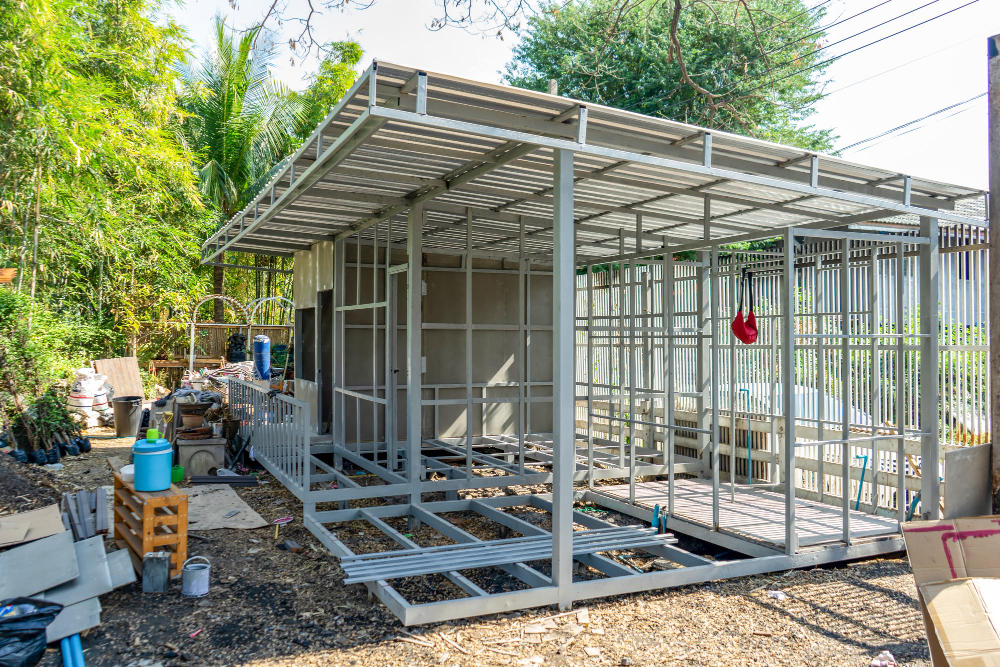Last updated on
For many people, creating their ideal house is a lifelong goal. It’s a place that expresses your individuality, creates memories, and offers you and your loved ones a safe refuge. However, picking the correct building materials is crucial for such a big investment.
While conventional materials like wood have their allure, steel is becoming more known for several advantages, including extraordinary durability.
Standing Firm: Steel’s Natural Strength

Because of its amazing strength-to-weight ratio, steel is well known. This indicates that it is pressure-resistant and able to support enormous loads. This is especially helpful in areas that frequently experience high winds, significant snowfall, or earthquake activity.
The weight of the whole building, including the insulation, interior finishes, and roofing materials, may be easily supported by a steel frame. This equates to a house that will be structurally sound for many generations, even during severe weather.
Flexible design possibilities are also made possible by this strength. With steel framing, large, open floor layouts may be built with fewer load-bearing walls. This increases the feeling of openness in your living spaces and gives you more customization options.
Withstand the Weather: Reliability You Can Trust
Unlike wood, steel is not susceptible to insect infestation, warping, or deterioration. It won’t be damaged by dampness or turn into a haven for mould and mildew. This results in a living space that is healthier and lowers the possibility of structural problems that may come from organic decay. Canada is the global leader in steel construction technology.
The steel building industry in Canada is well known for its emphasis on innovation and quality. They follow tight building rules, use premium steel, and use cutting-edge fabrication processes. Selecting Canadian steel buildings will give you peace of mind that your house is made to last and satisfies the highest performance and safety requirements.
In addition, modern steel building materials come with advanced protective coatings like galvanization. This zinc-rich coating acts as a barrier to prevent rust and corrosion, especially in damp or close-to-ocean conditions.
With proper maintenance, a steel home may retain its structural soundness and visual attractiveness for far over a century, providing exceptional long-term value for your investment.
An Eco-friendly Option for the Builder

Surprisingly, steel is a construction material that is safe for the environment. It is entirely recyclable, and recycled materials make up a sizable portion of the steel utilized in contemporary construction.
As a result, the environmental harm caused by industrialization and resource extraction is reduced. Additionally, steel buildings require less time to erect on site, which minimizes disruption to the neighbourhood.
Because of steel’s natural strength, extremely energy-efficient houses may be built. Thermal performance may be enhanced by properly insulating steel-framed walls. Lower energy costs and a smaller carbon footprint for your house result from this.
Flexibility in Design
Steel offers unparalleled architectural adaptability, allowing architects and builders to create innovative and modern home designs. Steel’s strength allows for greater spans and open floor plans without the need for load-bearing walls, resulting in more spacious and useful living areas. Prefabricated steel may also be built off-site, reducing construction time and causing less disruption to the environment.
Its adaptable architecture also makes additions and alterations simple. Steel buildings may be modified to accommodate shifting requirements without sacrificing the building’s general structural integrity, whether it’s by adding a new room or using new technology.
Financial Success
Even though steel might initially cost more than other materials, in most cases the long-term financial advantages surpass the initial outlay. Over time, homeowners may save money on repairs and replacements since steel is durable and requires little upkeep. Prefabricated steel components can also expedite construction, save labour expenses, and shorten project schedules.
Because of these cost advantages, Canadian steel structures are becoming more well-liked in the Canadian market. Both builders and homeowners are realizing the importance of investing in a material that offers both short- and long-term advantages.
Efficiency in Energy Use
Steel homes are capable of becoming extremely energy-efficient in design. By reflecting heat away from the building, steel’s reflective qualities can save on cooling expenses. Furthermore, high-performance windows, doors, and insulation may be readily installed in steel constructions, improving the home’s total energy efficiency.
Steel homes can reduce utility costs and carbon emissions by using less energy, which is in line with the rising demand for ecologically friendly building methods.
The Takeaway
Steel is a great material for building homes since it has a lot of benefits. Strength and longevity guarantee long-lasting and secure construction. Pest and fire resistance increases house safety and lowers maintenance expenses.
Steel has an extremely high melting point, which considerably slows the spread of fire within a house. This reduces property damage and gives residents crucial time to leave safely.
Steel construction is frequently quicker than traditional techniques. Because steel components are prefabricated off-site, there is consistency in quality and labour expenses are decreased on-site.
This means that the building will go more quickly, enabling you to move into your ideal house sooner. Steel is a wise choice for contemporary house building due to its economic efficiency, architectural flexibility, and sustainability.
Table of Contents




